| |
 
CHALTON
AND IDSWORTH
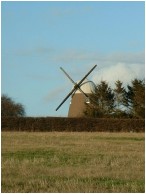 |
|
High above the
roaring traffic on the road to Portsmouth
stands the familiar sight of Chalton
Windmill. There has been a mill here
since 1289, and it is clearly shown on
Speed’s map of 1611. The present
tower brick mill was built about two
hundred years ago, and after years of
decay has been restored and turned into a
private residence.
Follow the lane for half a mile to the
east, past the restored iron age farm and
Roman villa, and you come to another
famous landmark – the Red Lion at
Chalton, said to be the oldest inn in
Hampshire. Standing opposite the 13th
century church of St. Michael, it is a
two storey timber-framed building
probably dating from the 15th century,
the recessed centre part of the upper
storey typical of such houses found
throughout the Weald. It may well have
been used as a hostel for dignitaries
attending the church and the adjacent
manor. |
But the village goes back
further still. Thirty years ago, a team of
archaeologists from Southampton University, led
by Barry Cunliffe, excavated an Anglo-Saxon
hill-top village behind the church on Church
Down, unearthing traces of sixty timber
structures of the sixth century. Gradually,
however, the village moved down the hill to its
present site round the church.
The manor of
Chalton occupied a large area from
Blendworth to Clanfield, and belonged to
Earl Godwin, passing to his son Harold in
1053. It was seized by William the
Conqueror, and given to William
Fitz-Osbern, Earl of Hereford and Lord of
the Isle of Wight.
By the time of the Domesday Survey it was
in the hands of the Earl of Shrewsbury,
one of whose successors forfeited it to
King Henry I. It remained in noble hands
for six hundred years until the time of
Cromwell. In 1780 it was bought by
Jervoise Clarke-Jervoise, who soon
afterwards bought the manor of Idsworth,
and became the first Lord of the Manor to
live in the parish. |
|
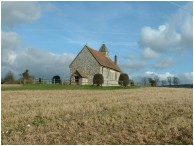 |
Idsworth, with its tiny
chapel a familiar sight from the
London-Portsmouth train, is not mentioned in the
Domesday Book, and was probably included in the
manor of Chalton. It was separated from Chalton
when the third Earl’s lands were forfeited
to the crown, and given to the Earl of Leicester.
Like Chalton, the manor remained in the gift of
the King throughout the middle ages, until it,
too, was bought by Clarke-Jervoise in 1789.
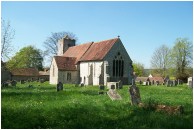 |
|
The old house was
demolished in 1840 to make way for the
railway and a substantial new house built
in 1852, which remained home to five
generations of the family (and up to
eleven servants!) for 120 years.
Jervoise’s son, Sir Samuel, became
Rector of Chalton and Idsworth in 1798,
and his son, another Jervoise, was Member
of Parliament for South Hampshire between
1857 and 1868.
The diaries of his wife, the Lady
Georgiana, give us an insight into the
life of the aristocracy in the 19th
century: hunting, shooting and
entertaining, whilst spending much of the
summer season at their magnificent London
house in Bryanston Square and paying
frequent visits to the opera at Covent
Garden. |
The last member of the
family, Major Arthur Clarke-Jervoise, died in
1977, and Idsworth Park was sold the following
year. It has been split into private apartments,
managed by a Residents Association. Along with
the demise of the family came the closure of the
two village schools, which had opened in the
1850s, Chalton with fifty-three pupils and
Idsworth with eighty-three.
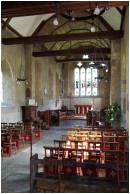 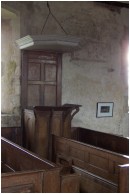 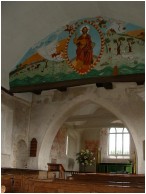 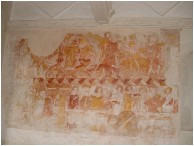
St. Hubert’s Chapel is
well known for its mediaeval wall paintings.
Above a vivid picture of Salome dancing before
Herod, is a mysterious hunting scene, perhaps
reflecting the fact that in late Saxon times,
Earl Godwin used to hunt nearby. A huntsman winds
his horn, encouraging lively dogs to jump at a
mysterious half-human creature emerging from the
woods, which appears to be receiving a blessing
from another figure. It is brilliantly executed
and well preserved, but no two experts seem to
agree as to its interpretation.
The current theory
is that it represents the absolution of a
hermit who once seduced and murdered a
king’s daughter. As a penance he
undertook to walk on all fours until he
was forgiven.
Chalton and Idsworth are special, secret
places, witness to a thousand years of
recorded history, and, despite a new
wall-painting above the chancel arch at
St. Hubert’s, the closure of the
schools and the sale of the big house,
hardly touched by the 20th century. And
yet they are within earshot of
today’s traffic and a mere
stone’s throw from the urban sprawl
that is Portsmouth.
|
|
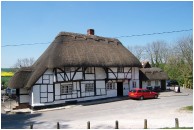 |
Tom Muckley, June 2004
This article was originally
published by the
Petersfield Post
tommuckley.co.uk
|
|









